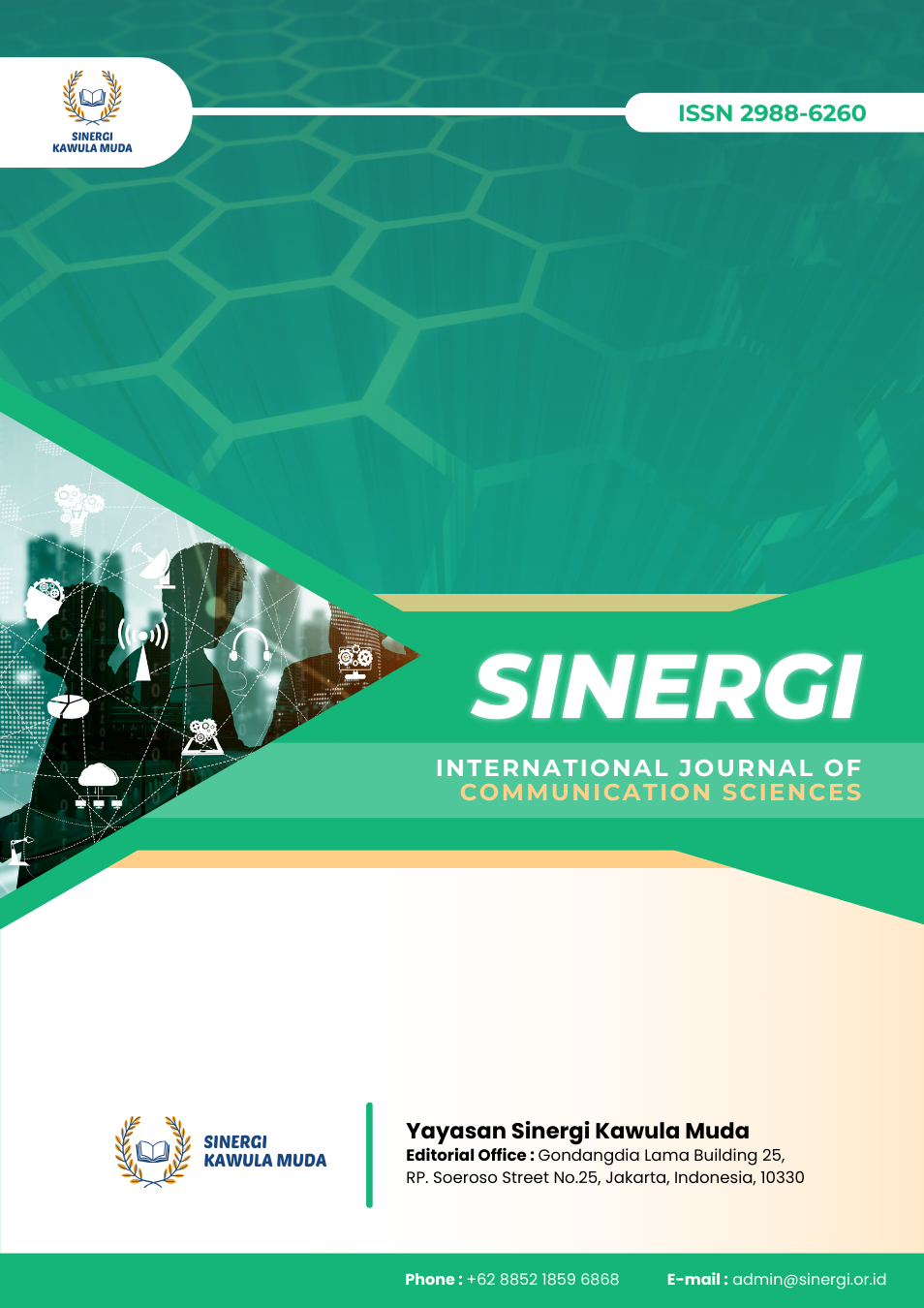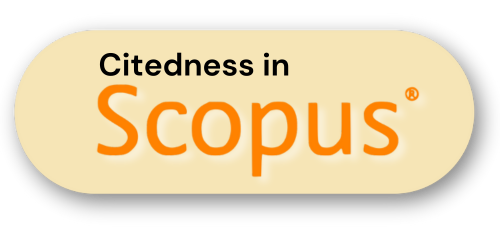The Rhetorical Strategy of Putri Karlina in Building the Image of a Female Leader in the Garut Regional Election
DOI:
https://doi.org/10.61194/ijcs.v3i3.857Keywords:
Political Rhetoric, Female Leadership, Ethos, Pathos, LogosAbstract
Women’s representation in Indonesian local politics is hindered by structural and cultural barriers, including gender stereotypes that deem women less suitable for leadership. This study explores how Putri Karlina navigated these challenges during the 2024 Garut Regional Election. Using a qualitative approach, data were gathered through in-depth interviews with her media team, observations of campaign activities, and analysis of social media content. The study focuses on Karlina’s rhetorical strategies, drawing on Aristotle’s ethos, pathos, and logos. The results show that Karlina strengthened her credibility (ethos) by consistently engaging with the community and addressing social issues. She used emotional appeals (pathos) through personal stories, local language, and empathetic interactions to connect with voters. Additionally, she employed logical arguments (logos) by presenting data-driven visions and concrete solutions to public problems. This combination of rhetorical strategies not only enhanced her public image as a competent and empathetic leader but also helped overcome gender biases in a male-dominated political environment. The findings contribute to the understanding of gender dynamics in political communication, especially in the context of local elections.
References
Abrams, E. M., & Greenhawt, M. (2020). Risk Communication During COVID-19. Journal of Allergy and Clinical Immunology: In Practice, 8(6), 1791–1794. https://doi.org/10.1016/j.jaip.2020.04.012 DOI: https://doi.org/10.1016/j.jaip.2020.04.012
Amjad, M. (2023). Discourse Analysis of Rhetorical Linguistic Modes in Digital Marketing Brand Slogans for Enhancing Consumer Attraction and Engagement: A Corpus Study. Pakistan Social Sciences Review, 7(III). https://doi.org/10.35484/pssr.2023(7-iii)13 DOI: https://doi.org/10.35484/pssr.2023(7-III)13
Apriyani, E., Amrullah, M. N. U. R., & Hatta, H. (2020). Two-Way Symmetric Communication in Building Public Relations with Media (A Study on the Public Relations of the Government of Gowa Regency. Jurnal Washiah, 1(3), 501–516. https://journal.uin-alauddin.ac.id/index.php/washiyah/article/view/16234
Ayunda, C., Meliasanti, F., & Setiawan, H. (2021). Rhetoric in President Jokowi’s “Global Health Summit” Speech and its Recommendations for Teaching Speech Texts. Jurnal Pendidikan Tambusai, 5(3), 9464–9470. https://jptam.org/index.php/jptam/article/view/2507
Azzikra, M. J. D., Dinanti, M., & Rusta, A. (2024). Utilizing Instagram for Political Campaigns: Strategies and Impacts in West Sumatra. Jurnal, 3(2), 90–97. http://www.ejournal.stisipimambonjol.ac.id/index.php/SIMBOL/article/view/145
Balkis, A. H. (2020). Women’s Leadership Style in Public Institutions: A Case Study of Susi Pudjiastuti. Jurnal Ilmu Administrasi Negara (JUAN, 8(1), 79–88. https://doi.org/10.31629/juan.v8i1.2271 DOI: https://doi.org/10.31629/juan.v8i1.2271
Barokah, I., Basuni, A., & Nur’aeni. (2024). The Credibility of Notary Leaders among Employees (A Quantitative Descriptive Study on the Employees of Notary Joice Hapsari Fendrini. S.H, M.Kn, M.H.). OMNICOM: Jurnal Ilmu Komunikasi, 10(1), 50–63. https://ejournal.unsub.ac.id/index.php/FIKOM/article/view/2088 DOI: https://doi.org/10.25008/jkiski.v10i1.1187
Faraid, F. F., Hamad, I., & Sari, Y. (2023). Political Communication Discourse for Politicians in Maintaining Their Existence through Forensic Communication Perspective. WACANA: Jurnal Ilmiah Ilmu Komunikasi, 22(2), 380–391. https://doi.org/10.32509/wacana.v22i2.3523 DOI: https://doi.org/10.32509/wacana.v22i2.3523
Faridah, S., Mulkiyan, E., D., R., & Yusuf, M. (2021). Barriers and Solutions in Contemporary Political Communication. RETORIKA: Jurnal Kajian Komunikasi Dan Penyiaran Islam, 3(1), 1–27. https://doi.org/10.47435/retorika.v6i1.2678 DOI: https://doi.org/10.47435/retorika.v3i1.577
Gabriella, F., Asyiffa, A., & Sitorus, F. K. (2023). Analysis of Aristotle’s Views on the Five Functions of Language in Communication. JKOMDIS: Jurnal Ilmu Komunikasi Dan Media Sosial, 3(3), 725–729. https://doi.org/10.47233/jkomdis.v3i3.1247 DOI: https://doi.org/10.47233/jkomdis.v3i3.1247
Isa, A. (2024). Rhetoric of Prabowo Subianto in the First 2024 Presidential Debate (pp. 143–168). https://doi.org/10.23917/komuniti.v16i2.5492 DOI: https://doi.org/10.23917/komuniti.v16i2.5492
Ivana Theo Philia, Y. N. (2024). The Impact of the Development of Indonesian Democracy on Unity in Political Diversity. Gaining Public Support, 2(3). https://doi.org/10.55606/lencana.v2i3.3762 DOI: https://doi.org/10.55606/lencana.v2i3.3762
Koszowy, M., Budzynska, K., Pereira-Fariña, M., & Duthie, R. (2022). From Theory of Rhetoric to the Practice of Language Use: The Case of Appeals to Ethos Elements. Argumentation, 36(1), 123–149. https://doi.org/10.1007/s10503-021-09564-0 DOI: https://doi.org/10.1007/s10503-021-09564-0
Lino, M. M., Djani, W., Noh, M., & Cervesius, B. (2025). The Importance of Data and Information for Sustainable Village Development Planning (Vol. 5, Issue 1, pp. 49–58). https://doi.org/10.54082/jamsi.1422 DOI: https://doi.org/10.54082/jamsi.1422
Listiyani, F., & Muliawati, L. (2023). Persuasive Style in the Application of Logos on TikTok @vmuliana Career Tips Viewed from Aristotle’s Perspective. Ilmu Komunikasi, 8, 8–13. https://www.repository.urecol.org/index.php/proceeding/article/view/2699
Manullang, J., & Rahmanita. (2025). The Influence of Organizational Communication Patterns and Information Transparency on Audience Trust and Engagement in TVRI’s Digital Media. Medium, 13(1), 1–15. https://doi.org/10.25299/medium.v13i1.20166 DOI: https://doi.org/10.25299/medium.v13i1.20166
Muhlis. (2021). The Polemic of the 2020 Regional Election During the COVID-19 Pandemic: Between Democracy and Oligarchy. Ganaya Jurnal Ilmu Sosial Dan Humaniora, 4(1), 116–141. https://jayapanguspress.penerbit.org/index.php/ganaya/article/view/1253
Nazila, M. F., Daud, R. F., Fatchuriza, M., Komunikasi, P. I., Sri, U. S., Pemerintahan, P. I., & Sri, U. S. (2025). Social Media as a Political Communication Tool in Shaping the Image of Presidential Candidates (Vol. 1, Issue 3, pp. 499–505). https://doi.org/10.63822/rg3d0m84 DOI: https://doi.org/10.63822/rg3d0m84
Noorikhsan, F. F., Ramdhani, H., Sirait, B. C., & Khoerunisa, N. (2023). The Dynamics of the Internet, Social Media, and Politics in the Contemporary Era: A Review of the State-Society Relationship. Journal of Political Issues, 5(1), 95–109. https://doi.org/10.33019/jpi.v5i1.131 DOI: https://doi.org/10.33019/jpi.v5i1.131
Nurhadi, Z. F. (2020). YouTube as a Source of Beauty Information for the Millennial Generation. Commed: Jurnal Komunikasi Dan Media, 4(2), 170–190. https://doi.org/10.33884/commed.v4i2.1585 DOI: https://doi.org/10.33884/commed.v4i2.1585
PRATIWI, R. M., ADNAN, I. Z., & Sanusi, M. A. P. (2023). Integrated Marketing Communication Strategy of PT GO-JEK in GO-FOOD Services. Commed Jurnal Komunikasi Dan Media, 7(1), 58–73. https://doi.org/10.33884/commed.v7i1.6412 DOI: https://doi.org/10.33884/commed.v7i1.6412
Purwo, R. H. S., & Puspasari, D. (2020). The Role of Public Relations in Enhancing the Positive Image of the East Java Provincial Human Resource Development Agency (BPSDM. Jurnal Pendidikan Administrasi Perkantoran (JPAP, 8(3), 458–467. https://doi.org/10.26740/jpap.v8n3.p458-467 DOI: https://doi.org/10.26740/jpap.v8n3.p458-467
Raflina, R., Poernomo, M. I., Info, A., Rhetoric, A., & Raka, G. R. (2025). Gibran Rakabuming Raka’s Rhetoric in the 2024 Vice Presidential Debate in the Study of Aristotle’s Rhetoric (Vol. 4, Issue 6, pp. 725–734). DOI: https://doi.org/10.53625/ijss.v4i6.10023
Rego, A., Meyer, M., Júnior, D. R., & Cunha, M. P. e. (2025). Wise Leaders Fostering Employees’ Speaking-Up Behaviors: Developing and Validating a Measure of Leader-Expressed Practical Wisdom. Review of Managerial Science, 19(1), 157–195. https://doi.org/10.1007/s11846-024-00740-6 DOI: https://doi.org/10.1007/s11846-024-00740-6
Sarah Eka Maharani, N., & Rusdiana, J. (2025). Political Branding of Astrid Widayani on Instagram: Mitsikopoulou Theory Analysis in the Surakarta 2024 Election Campaign. Jurnal Komunikasi, 16(1), 33–43. https://doi.org/10.31294/jkom.v16i1.25573
Shahreza, M. (2023). Communication in Terms of Philosophy. SSRN Electronic Journal, 1–21. https://doi.org/10.2139/ssrn.4593956 DOI: https://doi.org/10.2139/ssrn.4593956
Williams, R. I., Raffo, D. M., Randy Clark, W., & Clark, L. A. (2023). A Systematic Review of Leader Credibility: Its Murky Framework Needs Clarity. Management Review Quarterly, 73(ue 4)). DOI: https://doi.org/10.1007/s11301-022-00285-6
Yulanda, A. (2020). The Implementation of Aristotle’s Virtue Ethics in the Contemporary Era. Jurnal Al-Aqidah: Jurnal Ilmu Aqidah Filsafat, 12(1), 90–104. https://doi.org/10.15548/ja.v12i1.1570 DOI: https://doi.org/10.15548/ja.v12i1.1570
Zamhasari. (2024). The Impact of the Regional Election (Pilkada) on Democracy: A Review of the Advantages and Disadvantages of Simultaneous Pilkada in Indonesia in (Vol. 3, Issue 10, pp. 873–880). https://bajangjournal.com/index.php/JPDSH/article/view/8470
Zamhuri, M. (2023). The Establishment of 30% Women’s Representation Quota in the Legislature for the Realization of Pancasila Justice. In Mewujudkan Sistem Hukum Nasional Berbasis Pancasila (pp. 16–32).
Zuhri, S., & Amalia, D. (2022). Gender Injustice and Patriarchal Culture in Indonesian Society. Murabbi: Jurnal Ilmiah Dalam Bidang Pendidikan, 5(1), 17–41. https://ejournal.stitalhikmah-tt.ac.id/index.php/murabbi/article/download/100/99
Downloads
Published
Issue
Section
License
Copyright (c) 2025 Revy Muzaqi Hersandi, Zikri Fachrul Nurhadi, Resty Mustika Partiwi

This work is licensed under a Creative Commons Attribution 4.0 International License.





